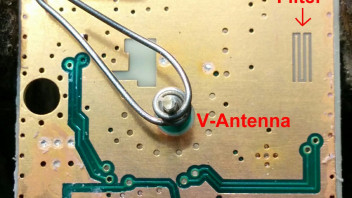As promised I made a test with 2 equal LNBs, one feeded Osc in-Pad only and one feeded Osc in- and out-Pad.
Damned, Mc Murphey was my friend in this test ....
I had 3 very cheap Single LNBs from Megasat "single gold" on stock.
One of it I shot to death in an earlier experiment.
They were extremely static-sensitive at the antennas, because the antennas are directly connected to HEMT-FETs.
Ok, so 2 left for this experiment 
I wound a ferrit bead trafo with enamelled copper wire as PA3FYM described and mouted it like the upper described Methode 1a.
First Tests in the lab gave good results, but then sudden the PLL stopped working at all .... So what happened ?
Mesurements showed something horrable : The isolation between primary and secondary windings got bad and so 12V powersupply was directly lead to the oscillator IC. Ouch !
So here a warning : Methode 1a is very dangerous ! You have to assure a good isolation between primary and secondary winding.
So the second LNB was shot to shot to death too 
Ok, no problem, they are cheap and I ordered another 3 LNBs.
Well, one LNB left on stock so let's do it again.
This time I smoothened the sharp edges of the ferrite bead, inside with a drill and outside with a file. Then I wound it with 0,1mm cotton sheathed enamelled copper wire. Actually I would prefer teflon coated wire, but I do not have it so thin. I made some isolation measurements and all was ok. Then I mounted it in the LNB. This time it works fine and I had to wait for the delivery of further LNBs.
When they arrived the typical shock came on me as to many other hams who modify LNBs ... It was the same Package but a complete different design.
Even the chips were different. The old PLL was with a 3566 IC, the new one with a 3568 IC.
To keep my test comparable I had to modify equal LNBs ...

This is the original LNB antenna side with antennas grounded.
(see the very interesting designed filter, I've never seen it this way before)

And the component side with removed x-tal
So again I wound 2 more ferrite beads as described before.

And mounted it as above.
At both LNBs I placed a 1n chip C at osc.in pin for DC decoupeling.
In one LNB I connected the other end of the winding to the osc.out pin and in the other LNB I connected it to ground. All x-tal ballast Cs were removed.
Then both LNBs were succsessively connected to a triplexer to which I feeded 12V DC and 25 MHz from my "indoor TCXO" which I desribed in other article in the forum. Between TCXO and triplexer I placed a 60 Ohm variable attenuator to give diffrent 25 MHz level. The output of the triplexer lead to an Avantest spectral analyzer.

This were the signals found with an oscilloscope at the osc. in and out pins at the "symmetrical" version.
No wonder that the level on the in pin is lower because the level on the out pin (other side of the transformer) is in 180 deg. phase shift and works against the transformated signal.

And this were the signals found at the in pin and to ground version.
The out pin is left open.
I find it interesting that the phase shift differs from 180 deg in this version.
Anyhow to get the pll to lock, in the symmetrical version much more Ref level is needed. And to get a clean noise- and jitterfree signal I even had to remove the internal pi attenuator in the indoor TCXO.

Here's an analyzer screenshot of the unmodified LNB with x-tal
(sorry I forgot to set the marker right, so the correction)

That's the symmetrical version with 100 mV ext. Ref (at the coax)
A lot of noise to see !

And here the same with 1V ext. Ref
Nice low noise and clean signal, as it should be.
(sorry I forgot to set the marker right, so the correction)
The "in pin only" version looks the same, but with much less drive power needed.
So now to the real test in the dish :

The Oscar100 CW-Beacon with the symmetrical ref feed.

And the Oscar100 CW-Beacon with the in-only ref feed.
The "in-only version" signal might look sharper and the noise lower, but that's not true.
This pictures are momentary captures. When I watch them for a longer time they are very equal. Also all other signals on Oscar100 look equal.
So here is my fazit : At the LNB Type I modified, it makes absolutely no difference in signalquality to feed ref symmetrical or not.
The only difference is, that the symmetrical feed needs much more ref power.
Anyhow it ist still a very nice and easy idea to place a trafo for decoupling the ref. I will keep using the in-only methode.
Does anyone know where to get 0.1 or 0.15mm teflon coated wire ?
best 73s
Armin DF1QE
![]()

